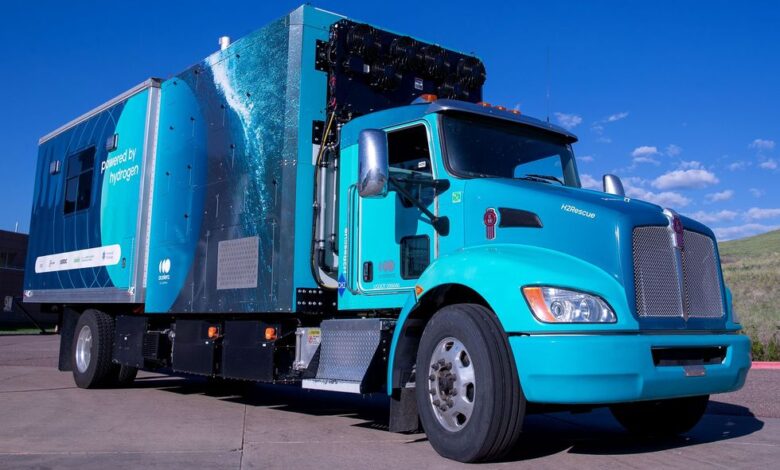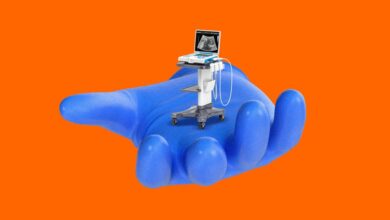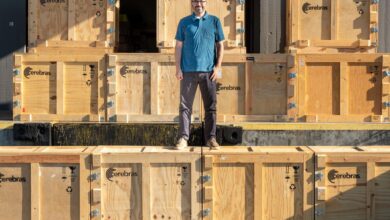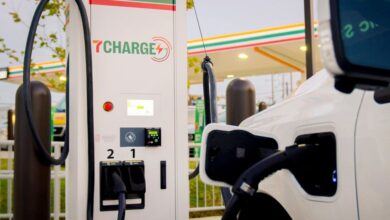Hydrogen Is Coming to the Rescue

A consortium of U.S. federal agencies has pooled their funds and wide array of expertise to reinvent the emergency vehicle. The hybrid electric box truck they’ve come up with is carbon neutral. And in the aftermath of a natural disaster like a tornado or wildfire, the vehicle, called H2Rescue, can supply electric power and potable water to survivors while acting as a temperature-controlled command center for rescue personnel.
The agencies that funded and developed it from an idea on paper to a functional Class 7 emergency vehicle prototype say they are pleased with the outcome of the project, which is now being used for further research and development.
“Any time the fuel cell is producing energy to move the vehicle or to export power, it’s generating water.” –Nicholas Josefik, U.S. Army Corps of Engineers Construction Research Lab
Commercial truck and locomotive engine maker Cummins, which has pledged to make all its heavy-duty road and rail vehicles zero-emission by 2050, won a $1 million competitive award to build the H2Rescue, which gets its power from a hydrogen fuel cell that charges its lithium-ion batteries. In demonstrations, including one last summer at National Renewable Energy Lab facilities in Colorado, the truck proved capable of driving 290-kilometers, then taking on the roles of power plant, mobile command center, and (courtesy of the truck’s “exhaust”) supplier of clean drinking water.
A hydrogen tank system located behind the 15,000-kilogram truck’s cab holds 175 kg of fuel at 70 megapascals (700 bars) of pressure. Civilian anthropology researcher Lance Larkin at the U.S. Army Corps of Engineers’ Construction Engineering Research Laboratory (CERL) in Champaign, Ill., told IEEE Spectrum that that’s enough fuel for the fuel cell to generate 1,800 kilowatt-hours of energy. Or enough, he says, to keep the lights on in 15 to 20 average U.S. homes for about three days.
The fuel cell can provide energy directly to the truck’s powertrain. However, it mainly charges two battery packs with a total capacity of 155-kilowatt-hours because batteries are better than fuel cells at handling the variable power demands that come with vehicle propulsion. When the truck is at a disaster site, the fuel cell can automatically turn itself on and off to keep the batteries charged up while they are exporting electric power to buildings that would otherwise be in the dark. “If it’s called upon to export, say, 3 kilowatts to keep a few computers running, the fuel in its tanks could keep them powered for weeks,” says Nicholas Josefik, an industrial engineer at CERL.
As if that weren’t enough, an onboard storage tank captures the water that is the byproduct of the electrochemical reactions in the fuel cell. “Any time the fuel cell is producing energy to move the vehicle or to export power, it’s generating water,” says Josefik. The result: roughly 1,500 liters of clean water available any place where municipal or well water supplies are unavailable or unsafe.
“When the H2Rescue drives to a location, you won’t need to pull that generator behind you, because the truck itself is a generator.” —Nicholas Josefik, U.S. Army Corps of Engineers Construction Research Lab
Just as important as what it can do, Josefik notes, is what it won’t do: “In a traditional emergency situation, you send in a diesel truck and that diesel truck is pulling a diesel-powered generator, so you can provide power to the site,” he says. “And another diesel truck is pulling in a fuel tank to fuel that diesel generator. A third truck might pull a trailer with a water tank on it.
“But when the H2Rescue drives to a location,” he continues, “You won’t need to pull that generator behind you, because the truck itself is a generator. You don’t have to drag a trailer full of water, because you know that while you’re on site, H2Rescue will be your water source.” He adds that H2Rescue will not only allow first responders to eliminate a few pieces of equipment but will also eliminate the air pollution and noise that come standard with diesel-powered vehicles and generators.
Larkin recalls that the impetus for developing the zero-emission emergency vehicle came in 2019, when a series of natural disasters across the United States, including wildfires and hurricanes, spurred action. “The organizations that funded this project were observing this and saw a need for an alternative emergency support,” he says. They asked themselves, Larkin notes, “‘What can we do to help our first responders take on these natural disasters?’ The rest, as they say, is history.”
Asked when we’ll see the Federal Emergency Management Agency, which is typically in charge of disaster response anywhere in the 50 U.S. states, dispatch the H2Rescue truck to the aftermath of, say, a hurricane, Josefik says, “This is still a research unit. We’re working on trying to build a version 2.0 that could go and support responders to an emergency.” That next version, he says, would be the result of some optimizations suggested by Cummins as it was putting the H2Rescue together. “Because this was a one-off build, [Cummins] identified a number of areas for improvement, like how they would do the wiring and the piping differently, so it’s more compact in the unit.” The aim for the second iteration, Larkin says, is “a turnkey unit, ready to operate without all the extra gauges and monitoring equipment that you wouldn’t want in a vehicle that you would turn over to somebody.”
There is no timetable for when the new and improved H2Rescue will go into production. The agencies that allocated the funds for the prototype have not yet put up the money to create its successor.
IEEE Spectrum



